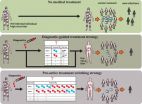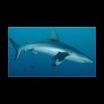Fossils help identify marine life at high risk of extinction today
Past extinctions could pinpoint vulnerable ocean ecosystems that need conservation
2015-04-30
(Press-News.org) A detailed study of marine animals that died out over the past 23 million years can help identify which animals and ocean ecosystems may be most at risk of extinction today, according to an international team of paleontologists and ecologists.
In a paper to be published in the May 1 issue of the journal Science, researchers from the University of California, Berkeley, and other institutions report that worldwide patterns of extinction remained remarkably similar over this period, with the same groups of animals showing similar rates of extinction throughout and with a consistent set of characteristics associated with elevated extinction risk.
The researchers then used these past global extinction patterns as a baseline to predict which ocean areas and marine organisms would be most at risk today without the added threat of human-caused habitat destruction, overfishing, pollution and ocean acidification.
Finally, the authors combined this natural or 'intrinsic' extinction risk with current threats from humans and climate change to obtain a global map of potential future hotspots of extinction risk.
"Our goal was to diagnose which species are vulnerable in the modern world, using the past as a guide," said lead author Seth Finnegan, an assistant professor of integrative biology at UC Berkeley. "We believe the past can inform the way we plan our conservation efforts. However, there is a lot more work that needs to be done to understand the causes underlying these patterns and their policy implications."
"It's very difficult to detect extinctions in the modern oceans, but fossils can help fill in the gaps," added co-author and conservation biologist Sean Anderson, a postdoctoral researcher at Simon Fraser University in Burnaby, British Columbia. "Our findings can help prioritize areas and species that might be at greater risk of extinction and that might require extra attention, conservation or management."
Marine extinctions with and without humans
The study found that animals with small geographic ranges are most at risk of extinction, Finnegan said. In addition, some groups tend to be more extinction-prone than others. For example, in the fossil record, whales, dolphins and seals show higher risk of extinction than sharks or invertebrates such as corals. Clams and mussels -- so-called bivalves -- had about one-tenth the extinction risk of mammals.
The authors used these patterns from the fossil record to assess the natural extinction risk of animals living in the oceans today. Comparing these patterns with areas where human activities such as fishing impact the oceans revealed areas that may be particularly sensitive. These areas included high- biodiversity regions of the tropics such as the Indo-Pacific and the Caribbean, as well as regions such as Antarctica that harbor many unique species.
"The implications of these patterns for the future of coastal marine ecosystems will depend on how natural risk and current threats interact," said co-author Paul Harnik, an assistant professor of geosciences at Franklin and Marshall College in Lancaster, Pennsylvania. ""By understanding these patterns in the past, we hope to provide a framework for understanding global change."
Bridging the gap
The analysis grew out of a series of meetings at the National Evolutionary Synthesis Center in Durham, North Carolina, which is funded by the National Science Foundation. The team agreed on the need to bridge the gap between the fossil record of marine animal extinction and what modern-day biologists are finding as they explore living ocean ecosystems.
The group focused on the past 23 million years when the planet looked largely the same as today: The continents were arranged similarly, and most of the same major taxonomic groups, from whales and seals to clams, snails and sea urchins, existed. However, this time interval encompassed dramatic changes in Earth's climate. The group determined that patterns of extinction risk were consistent despite this variability -- suggesting that the fossil record can provide a valuable pre-human baseline for considering current threats to marine biodiversity.
"Climate change and human activities are impacting groups of animals that have a long history, and studying that history can help us condition our expectations for how they might respond today," Finnegan said.
INFORMATION:
Other co-authors are from the United Nations Environment Program World Conservation Monitoring Center and the Computational Science Laboratory of Microsoft Research in Cambridge, the United Kingdom; Dalhousie University in Nova Scotia, Canada; the University of Massachusetts in Boston; Mount Allison University in New Brunswick, Canada; the University of Oslo in Norway; the College of William and Mary in Williamsburg, Virginia; the University of Washington in Seattle; the Smithsonian Tropical Research Institute in Panamá; and the University of Queensland in St. Lucia, Australia.
[Attachments] See images for this press release:


ELSE PRESS RELEASES FROM THIS DATE:
2015-04-30
Demand for seafood from wild fisheries and aquaculture around the world has nearly doubled over the past four decades. In the past several years, major retailers in developed countries have committed to source their seafood from only sustainably certified fisheries and aquaculture, even though it is not clear where that supply will come from.
A team of researchers led by the University of California, Davis, has focused its attention on fishery improvement projects, or FIPs, which are designed to bring seafood from wild fisheries to the certified market, with only a promise ...
2015-04-30
HIV-1 continues to spread globally. While neither a cure, nor an effective vaccine are available, recent focus has been put on 'treatment-for-prevention', which is a method by which treatment is used to reduce the contagiousness of an infected person. A study published this week in PLOS Computational Biology challenges current treatment paradigms in the context of 'treatment for prevention' against HIV-1.
Sulav Duwal, Max von Kleist and their collaborators develop and employ optimal control theory to compute and assess diagnostic-guided vs. pro-active treatment strategies ...
2015-04-30
Proteins inside a cell are in constant motion, changing shape continuously in order to carry out their functions. In addition, their multiple component atoms each have individual patterns of motion, making the entire protein a system of non-stop highly complex movement. Understanding how a protein moves is the key to developing drugs that can efficiently interact with it. But because of this complexity, protein motion has been notoriously difficult to study. Scientists at EPFL, IBS-Grenoble, and ENS-Lyon, have developed a new method for studying protein motion by first ...
2015-04-30
The fossil record helps to predict which kinds of animals are more likely to go extinct. When combined with information about hotspots of human impacts and climate-change predictions, Smithsonian scientists and colleagues pinpoint animal groups and geographic areas of highest concern for marine conservation in the May 1 issue of Science magazine.
"Just as some groups of people are more prone to health problems like diabetes or heart disease, we can tell from the fossil record which groups of animals are naturally more likely to go extinct," said Aaron O'Dea, paleontologist ...
2015-04-30
If you thought that a beetle with a machine gun built into its rear end was something that only exists in sci-fi movies, you should talk to Wendy Moore at the University of Arizona.
Many beetles secrete foul-smelling or bad-tasting chemicals from their abdomens to ward off predators, but bombardier beetles take it a step further. When threatened, they combine chemicals in an explosive chemical reaction chamber in their abdomen to simultaneously synthesize, heat and propel their defensive load as a boiling hot spray, complete with "gun smoke." They can even precisely ...
2015-04-30
SEATTLE, Wash. -- More than 1000 dams have been removed across the United States because of safety concerns, sediment buildup, inefficiency or having otherwise outlived usefulness. A paper published today in Science finds that rivers are resilient and respond relatively quickly after a dam is removed.
"The apparent success of dam removal as a means of river restoration is reflected in the increasing number of dams coming down, more than 1,000 in the last 40 years," said lead author of the study Jim O'Connor, geologist with the U.S. Geological Survey. "Rivers quickly erode ...
2015-04-30
CAMBRIDGE, Mass--Bombardier beetles, which exist on every continent except Antarctica, have a pretty easy life. Virtually no other animals prey on them, because of one particularly effective defense mechanism: When disturbed or attacked, the beetles produce an internal chemical explosion in their abdomen and then expel a jet of boiling, irritating liquid toward their attackers.
Researchers had been baffled by the half-inch beetles' ability to produce this noxious spray while avoiding any physical damage. But now that conundrum has been solved, thanks to research by a ...
2015-04-30
The vivid pigmentation of zebras, the massive jaws of sharks, the fight or flight instinct and the diverse beaks of Darwin's finches. These and other remarkable features of the world's vertebrates stem from a small group of powerful cells, called neural crest cells, but little is known about their origin.
Now Northwestern University scientists propose a new model for how neural crest cells, and thus vertebrates, arose more than 500 million years ago.
The researchers report that, unlike other early embryonic cells that have their potential progressively restricted as ...
2015-04-30
ORANGE, Calif. - Researchers in Chapman University's Argyros School of Business and Economics and their collaborators have just published a study on the evolution of yoga in the marketplace. Assistant Professor Gokcen Coskuner-Balli, Ph.D., co-authored the study, which examined how the meaning of yoga transformed in the past three decades. The results show that yoga became decreasingly associated with spirituality and increasingly associated with medicine and fitness. The study argues that the shift in the meanings are due to the changes in how yoga gurus are trained, market ...
2015-04-30
Flowering plants, also known as angiosperms, add an allure to the world that is unlike anything else in nature, but more importantly, they sustain us. Most of the fruits, vegetables, grains, beans, nuts, and even herbs and spices that we consume are produced by flowering plants. They all belong to the green plant branch of the tree of life, and a novel DNA analysis software program named MarkerMiner facilitates identification of genes that can be used to elucidate the evolutionary relationships between them.
University of Florida (UF) biologist Srikar Chamala, working ...
LAST 30 PRESS RELEASES:
[Press-News.org] Fossils help identify marine life at high risk of extinction today
Past extinctions could pinpoint vulnerable ocean ecosystems that need conservation




